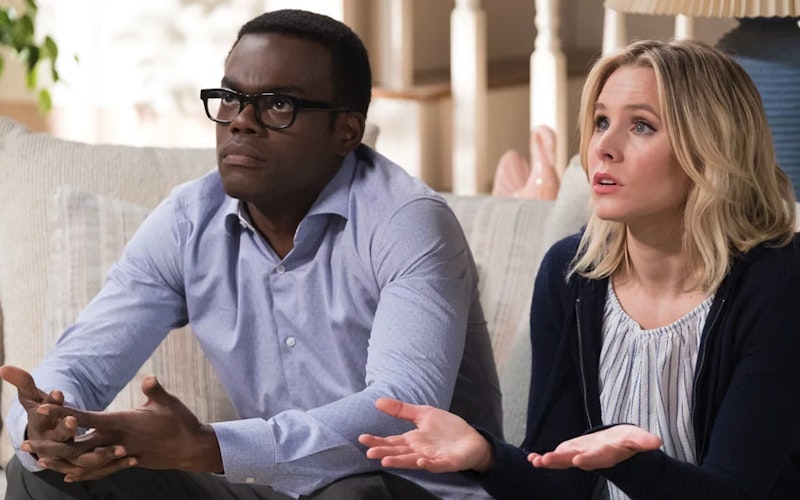
TV
Torture and Salvation in The Good Place
In his play No Exit, existential philosopher Jean-Paul Sartre placed three characters in a locked room in an obscure, post-life waiting area. They eventually discover that they’ve been put there to torture each other for eternity, leading one of them to speak the famous line, "Hell is other people."
At the end of its first season, NBC's The Good Place revealed a similar situation (spoilers ahead if you haven't caught up with the show). Previously it seemed that its four central characters—Eleanor Shellstrop (Kristen Bell), Chidi Anagonye (William Jackson Harper), Tahani Al-Jamil (Jameela Jamil), and Jason Mendoza (Manny Jacinto)—resided in “The Good Place,” an afterlife meant for those who had conducted themselves admirably on earth. But at the end of last season it was revealed that “The Good Place” is actually a neighborhood in “The Bad Place,” and that Michael (Ted Danson) is not its angelic administrator but actually a demon who had placed these four humans together to torture each other.
The specific torture for each character is slightly different. For Eleanor and Jason, the torture was believing they were in heaven by mistake and had to keep that secret. Chidi’s torture was the constant ethical dilemmas that Eleanor’s situation created for him. Tahani’s torture was not feeling connected with her soulmate.
In the current, second season, the two things that derail Michael’s devious plan are fascinating from a Christian perspective. First, Eleanor confesses that she is in “The Good Place” by mistake. The demons weren’t expecting such bold truth-telling; in fact, Eleanor herself did it spontaneously, acting against her usual nature of selfishness and self-preservation. This feels to me like an act of the Holy Spirit—the irresistible grace that is one of the key points in John Calvin’s TULIP. Yes, she chooses confession, which sets the wheels in motion for salvation. But something greater than her calls her to act in that moment.
Eleanor chooses confession, which sets the wheels in motion for salvation.
The second thing that confounds the demons is the growing friendship among the four humans, which deepens in a way that begins to counteract their vices. If “love covers over a multitude of sins,” then we see that in action in The Good Place. Before Eleanor makes her hell-altering confession, she is sitting next to Chidi at a town meeting, watching him writhe in stomach pain caused by his guilt over helping to cover up her secret. The scene is set at night, a dramatic contrast to the other, more cheerful town meetings, which took place during the day. Eleanor looks at Chidi, who is in pain next to her, leans over, touches his leg, and says, “I love you, man.” Then she takes the leap.
As the humans begin to care about each other more than themselves, they make sacrifices for each other. They become a team. In fact, they become a fellowship. At the end of season one, they become a fellowship with a purpose: to remember their situation, even after Michael has wiped their memory to begin the torture again, and to figure out a way out of the fake good place and into the real one.
At the beginning of season two, Michael tries over and over again to use the four humans to torture each other, but they keep figuring it out. Eventually the five of them form a pact, with the intriguing condition that Michael take ethics lessons from Chidi. Michael has an existential crisis and begins to have glimmers of goodness in himself, demonstrated by real friendship and affection toward Eleanor and the others. The fellowship has grown so strong that far from the original goal of humans torturing each other, their torturer is being drawn with them toward redemption.
There is a parable whose origins are obscure, shared by rabbis and pastors alike, of a vision of hell in which the residents are at a scrumptious feast but cannot eat because their spoons are too long. They are in torment in their hunger. Then the vision shifts to heaven, and it is the exact same scenario, except that the people are enjoying the feast because they are reaching across to feed each other.
At the end of No Exit, Sartre left his characters in hopeless bondage to each other's vices. In season two of The Good Place, we’re given a more redemptive arc, one that allows its four tortured souls to work together toward growth and virtue—and perhaps even an eventual escape. Hell has failed to be other people; it is now to be seen whether other people can, in fact, be enough to raise each other to heaven.
Topics: TV